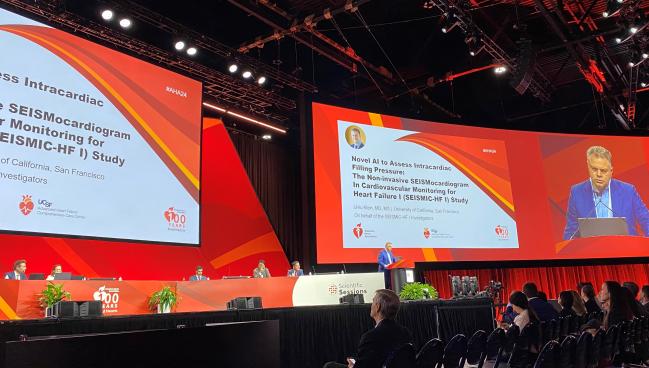Novel AI-Based, Noninvasive Sensor Can Accurately Measure PCWP in HFrEF
The preliminary data open the door to an alternative approach to invasive monitoring in heart failure patients.

CHICAGO, IL—A novel noninvasive intracardiac pressure monitoring device powered by artificial intelligence (AI) could be a potential alternative to invasive monitoring in patients with heart failure with reduced ejection fraction (HFrEF), according to new observational data.
Implantable pulmonary artery pressure (PAP) sensors have been shown to improve upon best medical care in patients with heart failure but are often costly and require an invasive procedure. The first such device, the CardioMEMS system (Abbott), was approved by the US Food and Drug Administration for patients with NYHA class III HF in 2014 based on data from the CHAMPION trial. That indication was expanded in 2022 to include NYHA class II HF or elevated natriuretic peptides based on evidence from GUIDE-HF. This year, the Cordella pulmonary artery sensor (Endotronix; Naperville, IL), also received the stamp of approval from the FDA for patients with NYHA class III HF with support from the PROACTIVE-HF trial. The CardioMEMS and Cordella systems are permanent implants, placed in the left and right pulmonary arteries, respectively.
Other noninvasive methods for gauging fluid retention—including patient questionnaires and "smart” scales—also have shown promise for predicting hospitalizations but lack the specific hemodynamic insights that implanted sensors can provide. More recently, innovators are turning to external sensors and patches, coupled with artificial intelligence, that can anticipate heart failure exacerbations that lead to urgent hospitalizations.
Liviu Klein, MD (University of California San Francisco), presented the SEISMIC-HF I findings at a late-breaking trials session at the American Heart Association 2024 Scientific Sessions. He explained that the move towards less-invasive approaches has been accompanied by a growing appreciation that “pulmonary capillary wedge pressure (PCWP) as a hemodynamic surrogate for managing patients may be more helpful, especially in patients who have postcapillary pulmonary hypertension. . . . The advances in noninvasive sensor technology and machine learning can actually help us to get these pressures in a noninvasive manner.”
The study involved use of the CardioTag (Cardiosense; Chicago, IL), an inch-and-a-half-long sensor that is placed on the sternum using two standard electrodes. Inside, it can detect seismocardiography, photoplethysmography, and ECG data, which are fed into a machine learning algorithm to estimate PCWP as well as classify patient congestion.
Good Agreement With Right Heart Cath
For the study, Klein and colleagues included 310 patients with HFrEF (mean age 61.1 years; 62% male) who were scheduled to undergo a right heart catheterization (RHC) procedure at one of 15 US sites between July 2023 and June 2024. Data from the CardioTag and a RHC pressure tracing procedure were collected simultaneously, with the former split into two cohorts for development (n = 186) and holdout testing (n = 47).
NYHA class at baseline was II in 23% of patients, III in 57%, and IV in 16%. Most patients had hypertension (84%), 32% had prior MI (32%), 55% had CAD, 46% had stage III-IV chronic kidney disease, and 71% had hyperlipidemia. Adherence to guideline-directed medical therapy was high, and patients were fairly evenly split between LVEF categories of 0-20%, 21-29%, and 30-40%.
Using RHC, mean right atrial pressure was 8.9 mm Hg, mean PAP was 29.6 mm Hg, and mean PCWP was 18.1 mm Hg. In the holdout set model, the algorithm performed well against RHC data, with a mean difference of 1.04 mm Hg (R = 0.74) and a level of agreement range between -9.9 and 11.9 mm Hg. There were no differences observed among subgroups stratified by sex, race, NYHA class, body mass index, clinical setting, hypertension, mitral valve regurgitation, pacemaker, or atrial fibrillation.
“These results provide an important step towards enabling widespread hemodynamic-guided remote management of HF patients,” Klein said, acknowledging that further work will be needed to expand the findings beyond the clinical setting as well as in other hemodynamic measures beyond PCWP.
Discussing the findings during the session, Jessica Golbus, MD (University of Michigan, Ann Arbor), said the CardioTag had “comparable performance” to the implantable CardioMEMS system. But remaining questions are: “can it predict clinical outcomes and can it intervene to change those clinical outcomes?” she said.
Additionally, Golbus said she’d like to see its performance evaluated “across a wide range of phenotypes, including patients with HFpEF. We need usability and acceptability data in real-world cohort settings outside the controlled catheterization lab. Finally, we need long-term studies of clinical outcomes.”
Yael L. Maxwell is Senior Medical Journalist for TCTMD and Section Editor of TCTMD's Fellows Forum. She served as the inaugural…
Read Full BioSources
Klein L. Novel AI to assess intracardiac filling pressure: the noninvasive SEISMocardiogram in cardiovascular monitoring for heart failure I (SEISMIC-HF I) study. Presented at: AHA 2024. November 16, 2024. Chicago, IL.
Disclosures
- Klein reports serving as a consultant for Abbott, Cardiosense, Edwards Lifesciences, and Medtronic.






Comments